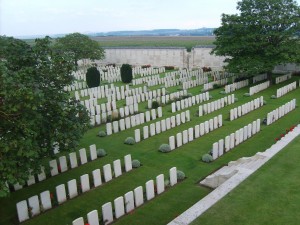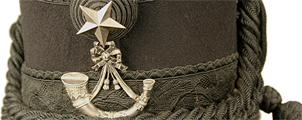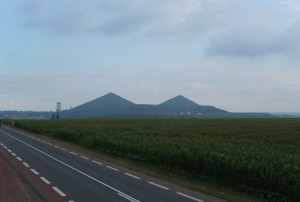The Battle of Loos
Friday 25th September marks the anniversary of the Battle of Loos. Although later eclipsed in scale by the Battle of the Somme in 1915, at the time it was the largest attack launched by the British Expeditionary Force of the War. Loos is also significant as it was in this battle that the British Army used poisoned gas for the first time.
Four battalions of The Cameronians (Scottish Rifles) were involved in the Battle, representing the regular army (1st Battalion), the Territorial Force (1/5th Battalion), and the recently formed service battalions of the New Army (9th and 10th Battalions).

Map showing the positions of the Battalions of The Cameronians (Scottish Rifles) involved in the Battle
Loos was a mining town, and the surrounding landscape was covered in mine workings, pit heads, and slag heaps, and would have no doubt felt quite familiar to the hundreds of men from Lanarkshire who would take part in the Battle, many of whom were miners in civilian life. Even today, the slag heaps of the famous ‘Double Crassier’ dominate the skyline south of Loos.
The attack commenced at 6:30am on the morning of Saturday 25th September. Gas was released in front of the 15th Division’s position 40 minutes ahead of the attack. Unfortunately the windy conditions resulted in some of the gas drifting back towards the British front, gassing their own men.
Many of the objectives of the attacking force were met that day, but a failure to bring up reinforcements in time to take advantage of gains made saw the advance falter. The 10th Battalion in particular had made steady gains, battling their way through Loos itself and on to the secondary objective of Hill 70. There the British forces encountered heavy resistance from the German defenders and it was found impossible to maintain hold of the hill.
The 9th Battalion attacked in support of the 10th Battalion Highland Light Infantry, who had suffered heavy casualites in the initial attack. A second attack by the 9th Scottish Rifles just after noon on 25 September was repulsed with heavy casualties.
The 1st and 1/5th Battalions were the Support and Reserve battalions of the 19th Brigade in its attack. When the initial attack by the leading battalions had been halted; orders were received by the 1st Battalion to prepare for a fresh advance. Thankfully the order was later cancelled when it was pointed out by the Commanding Officer of the 1st Battalion that the chances of success of any further attack was unlikely.
One of the casualties of the Battle was Private Jack Allen of the 10th Battalion who died of wounds on 27th September. Likely wounded on 25th, Private Allen was taken to the brewery at Philosophe where a Field Ambulance of the Royal Army Medical Corps had been established, and here he succumbed to his wounds. He was buried nearby in what is now Philosophe Cemetery. Sadly, the exact whereabouts of Private Allen’s grave were either never fully recorded, or were later lost; he is now commemorated on the Loos Memorial at Dud Corner Cemetery. A letter in the museum collection does however record that he had been buried at Philosophe.
It is difficult to establish exactly how many soldiers of The Cameronians (Scottish Rifles) became casualties in the Battle of Loos. Initial reports in Battalion war diaries often record those who had been killed as ‘Missing’, and it would be some time before these men were confirmed to have died. The publication Soldiers Died in the Great War records that 413 soldiers from the The Cameronian battalions at Loos died on 25th September 1915. Many of the soldiers who died have no known grave, and are recorded on the Loos Memorial at Dud Corner Cemetery. This cemetery occupies the site of the Lens Road Redoubt, one of the German strongholds taken by the 15th (Scottish) Division on the first day of the Battle.

Dud Corner Cemetery. The panels on the outer wall record the names of those whose graves are unknown.
Comments: 0





Leave a Reply